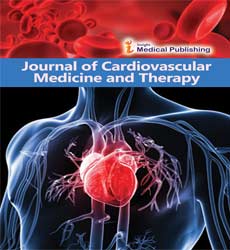Inflammation and Atherosclerosis: Mechanistic Insights and Therapeutic Targets
Céline Quentin*
Department of Cardiovascular Imaging, St. Francis Hospital and Catholic Health, Roslyn, NY 11589, USA
*Corresponding author:
Céline Quentin,
Department of Cardiovascular Imaging, St. Francis Hospital and Catholic Health, Roslyn, NY 11589, USA,
E-mail: Quentin.celine@icloud.com
Received date: February 01, 2025, Manuscript No. ipcmt-25-20685; Editor assigned date: February 03, 2025, PreQC No. ipcmt-25-20685 (PQ); Reviewed date: February 15, 2025, QC No. ipcmt-25-20685; Revised date: February 22, 2025, Manuscript No. ipcmt-25-20685 (R); Published date: February 28, 2025
Citation: Quentin C (2025) Inflammation and Atherosclerosis: Mechanistic Insights and Therapeutic Targets. J Cardiovasc Med Ther Vol.8 No.1:04
Introduction
Atherosclerosis is a chronic, progressive vascular disease characterized by the accumulation of lipids, inflammatory cells and fibrous elements within the arterial wall, leading to plaque formation and arterial narrowing. It is the underlying pathology of most cardiovascular diseases, including coronary artery disease, cerebrovascular disease and peripheral artery disease, which collectively remain the leading causes of morbidity and mortality worldwide. Traditionally, atherosclerosis was considered a passive process driven primarily by lipid accumulation; however, contemporary research has firmly established that inflammation plays a central and dynamic role in the initiation, progression and destabilization of atherosclerotic plaques [1].
Description
The pathogenesis of atherosclerosis begins with endothelial dysfunction, a process in which the vascular endothelium loses its homeostatic properties, including barrier function, nitric oxide production and anti-inflammatory signaling. Factors such as hypertension, hyperlipidemia, diabetes, smoking and oxidative stress disrupt endothelial integrity, allowing Low-Density Lipoprotein (LDL) cholesterol to accumulate within the subendothelial space.
Modified LDL particles, including oxidized LDL, act as pro-inflammatory stimuli, activating endothelial cells to express adhesion molecules such as vascular Cell Adhesion Molecule-1 (VCAM-1) and Intercellular Adhesion Molecule-1 (ICAM-1). These molecules facilitate the recruitment and attachment of circulating monocytes and T lymphocytes to the arterial wall [2]. Once recruited, monocytes differentiate into macrophages, which engulf modified LDL particles to form lipid-laden foam cells a hallmark of early atherosclerotic lesions known as fatty streaks. Foam cells secrete pro-inflammatory cytokines, chemokines and reactive oxygen species, amplifying local inflammation and perpetuating immune cell recruitment. T lymphocytes, particularly T-helper 1 (Th1) cells, produce Interferon-Gamma (IFN-γ), which further stimulates macrophage activation and promotes the pro-inflammatory milieu. Chronic inflammation leads to smooth muscle cell migration from the media to the intima, extracellular matrix deposition and plaque maturation [1].
As plaques progress, they may become unstable due to ongoing inflammation, matrix degradation and thinning of the fibrous cap. Inflammasomes, such as the NLRP3 complex, are activated in macrophages and other immune cells, leading to the production of interleukin-1β (IL-1β) and interleukin-18 (IL-18), key cytokines implicated in plaque destabilization. Plaque rupture exposes thrombogenic material to the bloodstream, triggering platelet activation, thrombus formation and potentially life-threatening events such as myocardial infarction or ischemic stroke. Endothelial erosion and intraplaque hemorrhage further contribute to acute cardiovascular events, highlighting the central role of inflammation in both chronic progression and acute complications of atherosclerosis [2].
Therapeutic targeting of inflammation in atherosclerosis has gained significant attention in recent years. Statins, initially developed for lipid-lowering, exhibit pleiotropic effects by reducing vascular inflammation, improving endothelial function and stabilizing plaques. Clinical trials, including the JUPITER study, demonstrated that statin therapy lowers High-Sensitivity C-Reactive Protein (hs-CRP), an inflammatory biomarker and reduces cardiovascular events independent of lipid levels. Beyond statins, novel anti-inflammatory strategies are under investigation. The CANTOS trial provided proof-of-concept that selective inhibition of IL-1β with canakinumab significantly reduced recurrent cardiovascular events in patients with previous myocardial infarction, highlighting cytokine targeting as a viable therapeutic approach. Other potential therapeutic strategies focus on modulating immune cell function, blocking adhesion molecules and targeting chemokine signaling pathways.
Monoclonal antibodies against IL-6, chemokine receptor antagonists and inhibitors of Toll-Like Receptor (TLR) signaling have shown promise in preclinical and early clinical studies. Additionally, lifestyle interventions, including dietary modification, regular physical activity, smoking cessation and stress reduction, exert anti-inflammatory effects and contribute to cardiovascular risk reduction. Mediterranean-style diets rich in fruits, vegetables, whole grains and polyunsaturated fats have been shown to lower circulating inflammatory markers and improve vascular function [1]. Emerging research in precision medicine and immunometabolism provides further opportunities to target inflammation in atherosclerosis. Genetic and epigenetic profiling of patients can identify individuals with heightened inflammatory risk, allowing tailored therapeutic approaches. Advances in nanotechnology enable targeted drug delivery to atherosclerotic plaques, enhancing efficacy while minimizing systemic side effects. Moreover, combination therapies that address both lipid dysregulation and inflammation are increasingly recognized as essential for comprehensive cardiovascular risk management [2].
Conclusion
Inflammation is a central driver of atherosclerosis, influencing every stage from endothelial dysfunction and plaque formation to rupture and acute cardiovascular events. Mechanistic insights into the cellular and molecular pathways of inflammation have revolutionized our understanding of atherogenesis and highlighted novel therapeutic targets. Cytokines, immune cells, adhesion molecules and signaling pathways represent key intervention points for reducing vascular inflammation and stabilizing atherosclerotic plaques. Evidence-based strategies to mitigate inflammation include statins, selective cytokine inhibitors, lifestyle interventions and emerging immunomodulatory therapies. Clinical trials have demonstrated the feasibility and efficacy of targeting inflammatory pathways, particularly in high-risk patients with established cardiovascular disease.
Personalized approaches, guided by genetic, metabolic and immunologic profiling, as well as innovative drug delivery systems, are poised to enhance the safety and effectiveness of anti-inflammatory therapies.
Acknowledgement
None.
Conflict of Interest
None.
References
- Freaney PM, Shah SJ, Khan SS (2020) COVID-19 and heart failurewith preserved ejection fraction. JAMA 324: 1499-1500.
Google Scholar Cross Ref Indexed at
- Hasty F, García G, Dávila H, Wittels SH, Hendricks S, et al. (2021)Heart rate variability as a possible predictive marker for acute inflammatory response in COVID-19 patients. Mil Med 186: e34–
Google Scholar Cross Ref Indexed at
Open Access Journals
- Aquaculture & Veterinary Science
- Chemistry & Chemical Sciences
- Clinical Sciences
- Engineering
- General Science
- Genetics & Molecular Biology
- Health Care & Nursing
- Immunology & Microbiology
- Materials Science
- Mathematics & Physics
- Medical Sciences
- Neurology & Psychiatry
- Oncology & Cancer Science
- Pharmaceutical Sciences
